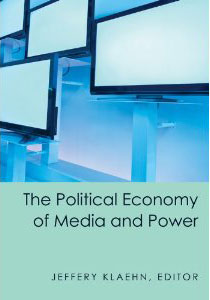
Book Review
The Political Economy of Media and Power
Editor: Jeffery Klaehn
Peter Lang Publishing, 2010, paperback, 376 pages, $38.95
Canadian sociologist Jeffery Klaehn has put together a penetrating collection of essays dealing with the political economy of the mass media spanning a broad range of topics. Although the British, Canadian and American writers are University Professors or PHD students, the essays are written in clear, simple, accessible prose.
Richard Lance Keeble in “Hacks and Spooks” writes about the close ties between British and American intelligence agencies and the mass media. The media has always closely cooperated with intelligence agencies in both countries, sharing the same political outlook and goals. The CIA, M15 and M16 have used the mass media to plant stories.
For instance, from 1948-77 M16 operated the information Research Department Office (IRD) where it ran dozens of Fleet Street journalists and news agencies across the globe. The IRD, set up by the Labor government in 1948, spread ” white” (true), “grey” (partially true) and “black” (false) propaganda about the former socialist countries of central Europe as well as “planting smears, lies, false rumors and forged official reports about the Soviet threat in the media”, writes Keeble.
The propaganda group successfully distorted anti-colonial struggles in countries such as Kenya, Malaya and Cyprus and covered up British atrocities. The CIA, M15 and MI6 also recruited journalists to spy for them in foreign countries, using their ability freely to enter enemy countries and reach top officials.
At home, the IRD conducted “psychological operations” against peace and progressive movements in the UK. M15 attempted several times to undermine Labor Party governments during the 1960s and 70s by leaking false information on top officials to sympathetic Fleet Street newspapers, Keeble reveals.
More recently, M16 used its press contacts to spread false information about Iraqi weapons of mass destruction to frighten the public into supporting a western attack against Iraq.
One BBC correspondent justified the media’s uncritical acceptance of disinformation by stating, “if M15 and M16 sometimes peddle disinformation, many viewers and readers may not very much care as ‘we’re all on the same side.’ “
The CIA ran its own propaganda unit modeled on the IRD during the 1960s called the Forum World Features to feed false information to the public. The Senate’s Church Committee and the House of Representative’s Pike Committee revealed in the 1970s that the CIA had invested large resources in propaganda operations. For instance, the CIA had a secret agreement with the New York Times to employ at least 10 agents as reporters or clerks in foreign bureaus. Feminist writer Gloria Steinem was revealed to be an agent. “The Pike Committee found that 29 per cent of the CIA’s covert operations was directed at ‘media and propaganda,’ meaning that in 1978 the agency had spent in this area as much as the combined budgets of the world’s biggest news agencies (AP, Reuters and UPI) put together”, Keeble writes.
The CIA planted a false story through Readers Digest in 1982 that the Turkish assassin who tried to kill Pope John Paul II was a KGB agent.
In the “The Faculty Filter”, Robert Jensen writes that after 24 years Noam Chomsky and Edward S. Herman’s magnum opus “Manufacturing Consent” is more relevant than ever.
Chomsky and Herman developed the propaganda model to show that the media’s positions on key issues will always reflect the thinking of the political and economic elite. US Journalism schools, which are tied the corporate media, do not teach the propaganda model because there are two basic types of faculty members: professionals who see the world in the same way as the corporate media; professors who are critical but lack the “moral capacity to step outside the privileges that come with their university positions” and are unwilling to risk confrontations with the media industry, writes Jensen.
James Winter in “Reporting on the Pharmaceutical Industry” documents how the industry markets dangerous drugs that kill and maim thousands, ghost write flawed scientific studies for medical researchers who are paid for their signature, invents non- existent diseases to create a market for their products and bribes doctors to sell their products, among other things.
The mass media, which loves to report on medical discoveries, cite corporate medical studies that only list the positive benefits of drugs and not possible side effects, providing free advertising. The corporate media also creates hysteria about non-existent health conditions, such as the swine flu pandemic in 2009 that never happened, so that governments will buy vaccines that enrich companies and shareholders.
Winter also suggests that the Canadian media has been critical of the Canadian public healthcare system and promote private participation because certain businessmen such as Paul Desmarais Sr., part owner of the Southam newspaper chain and other media, is also owner of powerful insurance companies that would benefit from privatization.
In “Appearance, Intimacy Exhibition, Hypersexualization and Pornography”, Richard Poulin and Melanie Claude write how the media is sexualizing young girls and teenagers through fashion, magazines, TV, the internet and the overall pornographying of culture. Corporations use sexualized images of young people to sell products. Young people are confronted with sexual images in video games, magazines, films and TV shows.
This early sexualization has led to the “emergence of a hyper sexualized society … where the female body is fragmented and objectified, and where the value of women is reduced to their physical attributes and their ability to please and seduce”, write Poulin and Claude.
The capitalist mass media, which has treated young women as commodities, normalize and promote pornography and prostitution. “Women’s liberation, a crucial conquest of the feminist movement, has been transformed by the no-liberal market into submissiveness to male pleasures.”
Klaehn’s “The Political Economy of Media and Power” is a thought provoking work that sheds light on the dark corners of capitalism and its media infrastructure. These above mentioned essays are just a small sampling of what awaits the reader in Klaehn’s fascinating book.










